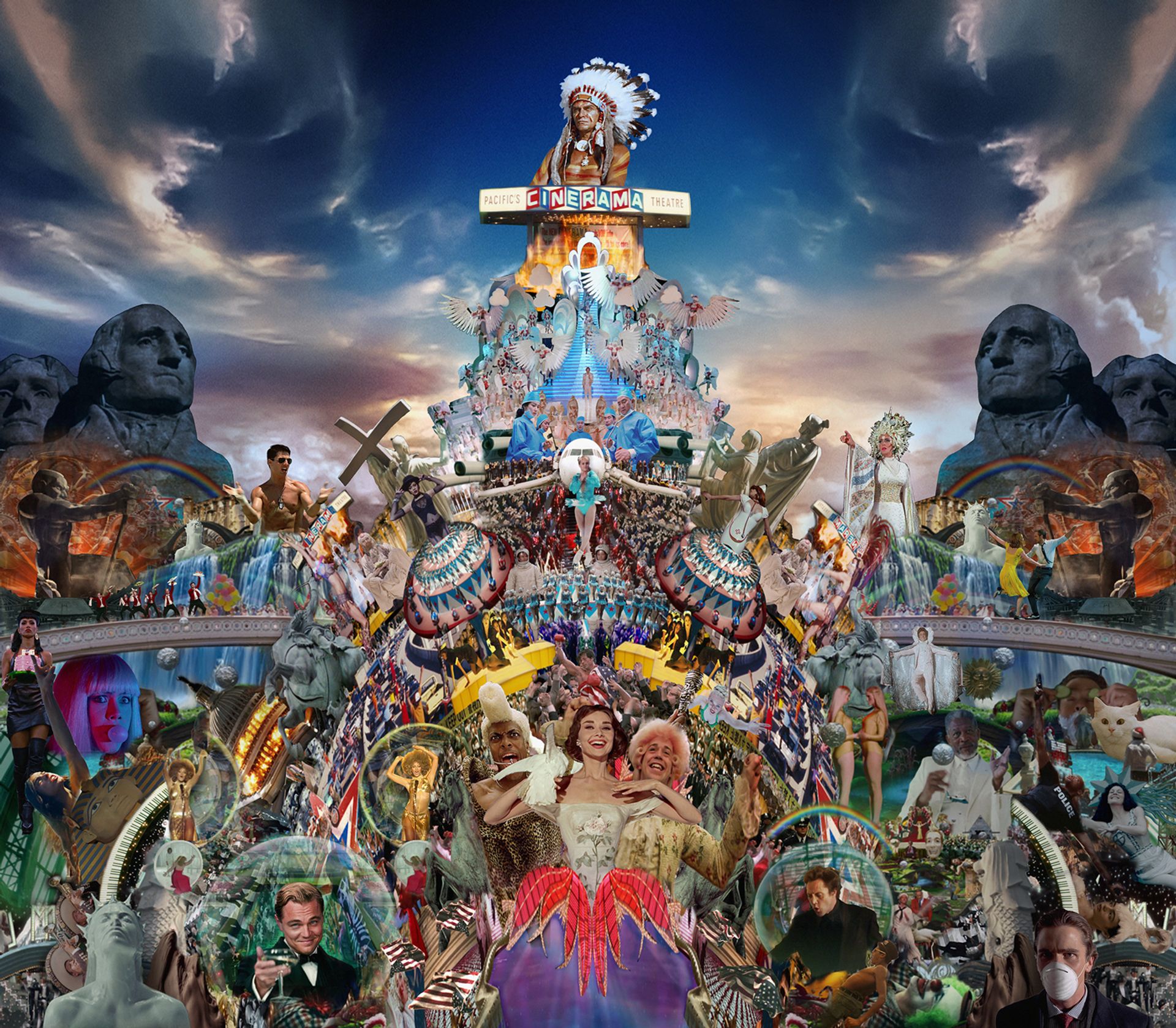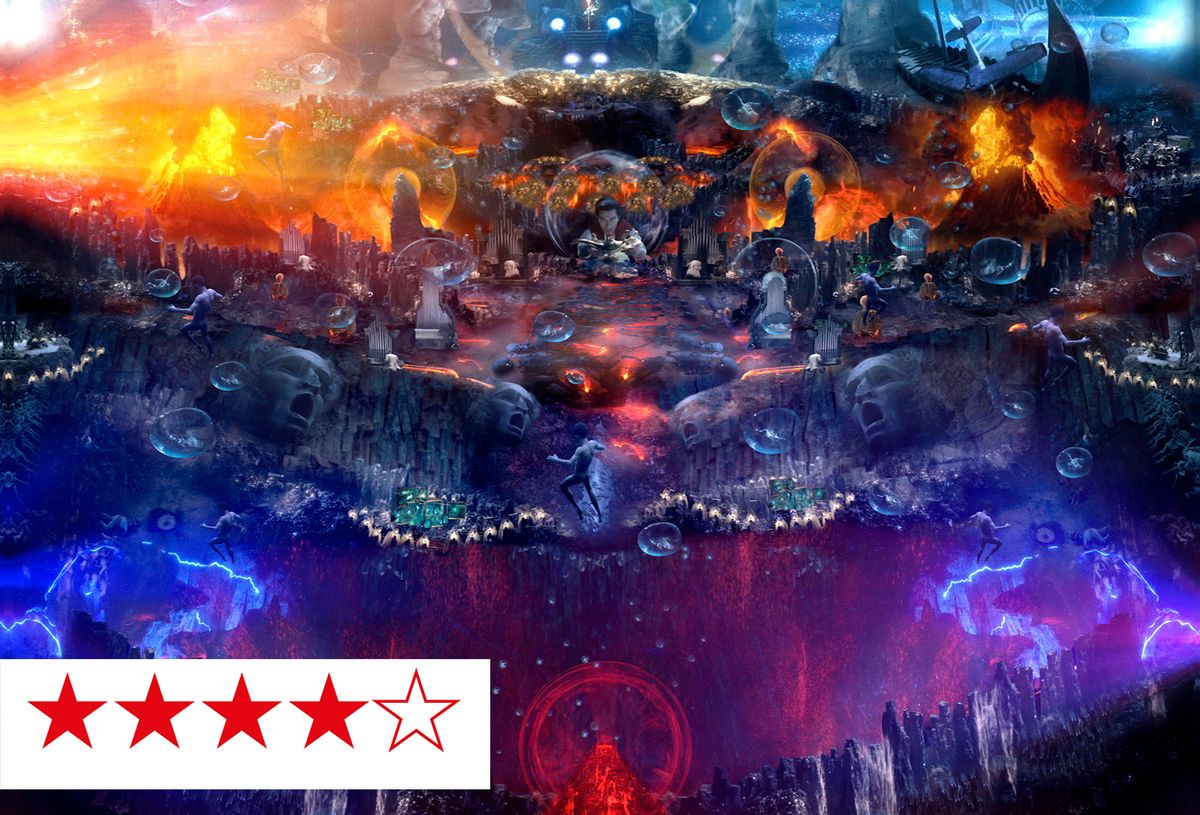Heaven's Gate, by Marco Brambilla
Marco Brambilla's Heaven's Gate is at Pérez Art Museum Miami (PAMM) until January 2022, as a video projection or on virtual reality (VR) headsets. The experience loops every 4 minutes 45 seconds, and is shown continuously during museum hours.
During Art Basel in Miami Beach—1 to 5 December 2021—the museum will showcase a larger VR viewing event using 20 HTC Vive Flow headsets, allowing a large group to experience Heaven's Gate simultaneously.
Marco Brambilla will be giving a talk at PAMM with the museum's director Franklin Sirmans at 1pm on Friday 3 December.
It was previously previewed at the Shed in New York City, during Frieze New York (5-9 May 2021).
Our panellists reviewed the experience remotely on Oculus Quest 2 headsets.
Curator's note
The Italian-born, London-based, Canadian artist and film director Marco Brambilla has been making video waves recently with some arresting explorations of art and drama in extended reality (XR). In September to November 2020 he showed The Four Temperaments at Michael Fuchs Galerie in Berlin. It features the actress Cate Blanchett and reimagines the theory of “personality types” based on four fundamental humours: sanguine, choleric, melancholic and phlegmatic. At the same time, Brambilla made the experience available on the Acute Art augmented reality (AR) smartphone app.
Heaven’s Gate is a video monument to Hollywood’s veneration of glamour while retelling the history of the world in seven distinct phases.Marco Brambilla
Thanks to the Covid-19 pandemic, Brambilla's collaboration with Marina Abramović on her monumentally conceived 7 Deaths of Maria Callas was given its first performance from the Staatsoper in Munich in April 2020 through livestream only. Brambilla created the tempestuous cloud-imagery video intermezzi representing the changing moods of the Greek-American opera diva, one of the greatest musicians of the 20th century. The work's scale could be appreciated for the first time at its first performance in front of an audience, at the same venue, in July 2021 with Abramović representing Callas on her Parisian death bed in 1977.
Scale is at the heart of Brambilla's Heaven's Gate. It is "a video monument to Hollywood’s veneration of glamour", as Brambilla puts it, "while retelling the history of the world in seven distinct phases". In his complex, looping, immersive, collage, Brambilla uses existing footage to create a digital tableau as a human figure ascends through seven stages of life, a parallel to the mountainous seven levels of Dante's Purgatory.
For audiences viewing it projected in 2D, in a museum setting, the narrative moves from bottom upwards, borrowing the narrative style of a Native American totem pole. And Brambilla addresses, in his abundant, crowded imagery, one of the areas of great artistic potential in virtual reality: playing with scale and its relationship to time.
Our panel viewed Heaven's Gate on the Oculus Quest 2 (soon to be rebranded as the Meta Quest 2). It is a headset whose optical performance, at a competitive price, is remarkable when one looks back at the first Oculus Rift headsets to come to market in 2014. But, as Eron Rauch points out below, it is still a piece of hardware that can reproduce only a lower-resolution version of the 8K majesty of Brambilla's original file. That is a calculus that artists, publishers and museums will have to engage with for some time to come—just as Corning Museum had to do with its beautifully conceived VR recreation of the Glass Drawing Room at Northumberland House—when using a consumer-level VR headset to present lower resolution experiences of high-fidelity work.
Louis Jebb

Seven levels of purgatory in fewer than five minutes: Heaven's Gate Courtesy of the artist and Pérez Art Museum Miami
Is it accessible?
Carole Chainon: The 360 experience is accessible only to museum visitors who can either view the video in 2D projected on to a dedicated gallery space—at PAMM—or in a VR headset on site.
Eron Rauch: We were given private download links, as the VR version of the work is otherwise only available on headsets at PAMM.
From a critical, art historical standpoint, how good is the art?
The video is a mesmerising, seamless collage. Incredible. I found myself watching the video several times just to be able to catch all the detail.Carole Chainon
Carole Chainon: The video is a mesmerising, seamless collage. Incredible. I found myself watching the video several times just to be able to catch all the detail. The production values—music, use of special effects, the references to pop culture and the way the artist takes us from one “level” to another—hit every target to make the video captivating to all audiences.
Eron Rauch: As the work is rooted in utilising tropes, archetypes, and clichés from Hollywood movies, it’s almost impossible not to just launch into a slurry of connections of maximalist US art and media. These include the layered combinations of Patrick Nagatani or Andrée Tracey; prestige TV openings; Daniel R. Small’s wry archaeology of the set of Cecil B De Mille's The Ten Commandments; “magic eye” books; California sci-fi cults; Broadway theatre set flats rotated by stagehands during musical numbers; and some manner of collision of 90s animated GIF-laden Tripod pages; and the panoramic fractalling of Jackson Pollock (dean of Modernist spectacle during the era of filmic material most used by Brambilla). The spectacle was certainly engaging (and I love maximalist art), but, like many works that re-present distilled spectacle, its irony never seemed to be able to provide enough power to create critical escape velocity from this even more weaponised spectacle.
What medium-specific qualities of VR/AR does it employ?
Carole Chainon: In a headset, the content makes use of the entire immersive space, there is something to see everywhere we look. The 360/VR is used as a medium here as opposed to a distribution tool. As a user, we are actively engaging with the artwork as we turn our heads wanting to take in all of the details and looking for an “easter egg hunt” of some sort, searching for references that we are familiar with, one way or another.
Given the referencing of golden age Hollywood cinema, I selected a vintage gilt-and-red-velvet movie palace as the setting for one of my watch-throughs, which created interesting resonances.Eron Rauch
Eron Rauch: The work itself neither utilises the medium of VR nor AR, as it is in effect a standard 3D-glasses-style video played in a VR environment. One interesting aspect that is external to the work, but certainly part of the experience, is that Bigscreen—an app used to watch movies on an Oculus headset—lets you change the theatre room you’re watching in. Given the referencing of golden age Hollywood cinema, I selected a vintage gilt-and-red-velvet movie palace as the setting for one of my watch-throughs, which created interesting resonances. This private screening only took a moment in a menu to arrange; which certainly would have been a significantly more... arduous, let’s say... process for a non-Hollywood studio executive to arrange at the Egyptian or the Aero theatres.

A homage to the Golden Age of Hollywood seen through the prism of Dante's Purgatory: Heaven's Gate Courtesy of the artist and Pérez Art Museum Miami
Does it break new ground technically?
Carole Chainon: Heaven’s Gate is extremely well achieved and should be a reference when artists consider VR as a medium of expression.
Newer mediums aren’t always better and more hi-definition. The source video is uncanny 8K resolution, but the movie display of common VR headsets, including the Rift 2, is far lower, making the details of the video mushy and vague.Eron Rauch
Eron Rauch: I recently revisited the show catalogue from Providence Poster Art, 1995-2005 (2006, Museum of Art, Rhode Island School of Design), itself an utter frenzy of work from the era of the Fort Thunder underground events and work space in Providence. While many of the works were also utterly maximalist and referencing Pop culture tropes, their insistently tactile and DIY mode is a useful frame to examine one of the large technical flaws in Heaven’s Gate VR: newer mediums aren’t always better and more hi-def. The source video is uncanny 8K resolution, but the movie display of common VR headsets, including the Rift 2, is far lower, making the details of the video mushy and vague—though screenshots will appear much more finely rendered. Even in a quality 3D movie theatre, there is significant optical resolution loss compared to a simple physical image.
The XR panel's ratings
Carole Chainon gave a rating of 5/5 stars.
Louis Jebb gave a rating of 4/5 stars.
Eron Rauch gave a rating of 3/5 stars.
Giving an overall panel rating of 4/5 stars
The Art Newspaper's XR Panel
Carole Chainon is the co-founder of JYC, a XR development and production studio based in LA with a presence in Europe, creating XR experiences for the entertainment and enterprise sector. She is also a Spark AR Creator.
Louis Jebb is a writer, editor and producer of content in virtual reality. He set up The Art Newspaper’s XR Panel in 2020. In 2014 he founded immersiv.ly, a maker of news content in virtual reality.
Eron Rauch is a writer at Riot Games, an artist, writer, and curator whose projects explore the infrastructure of imagination, with a focus on subcultures, video games, and photography history.


